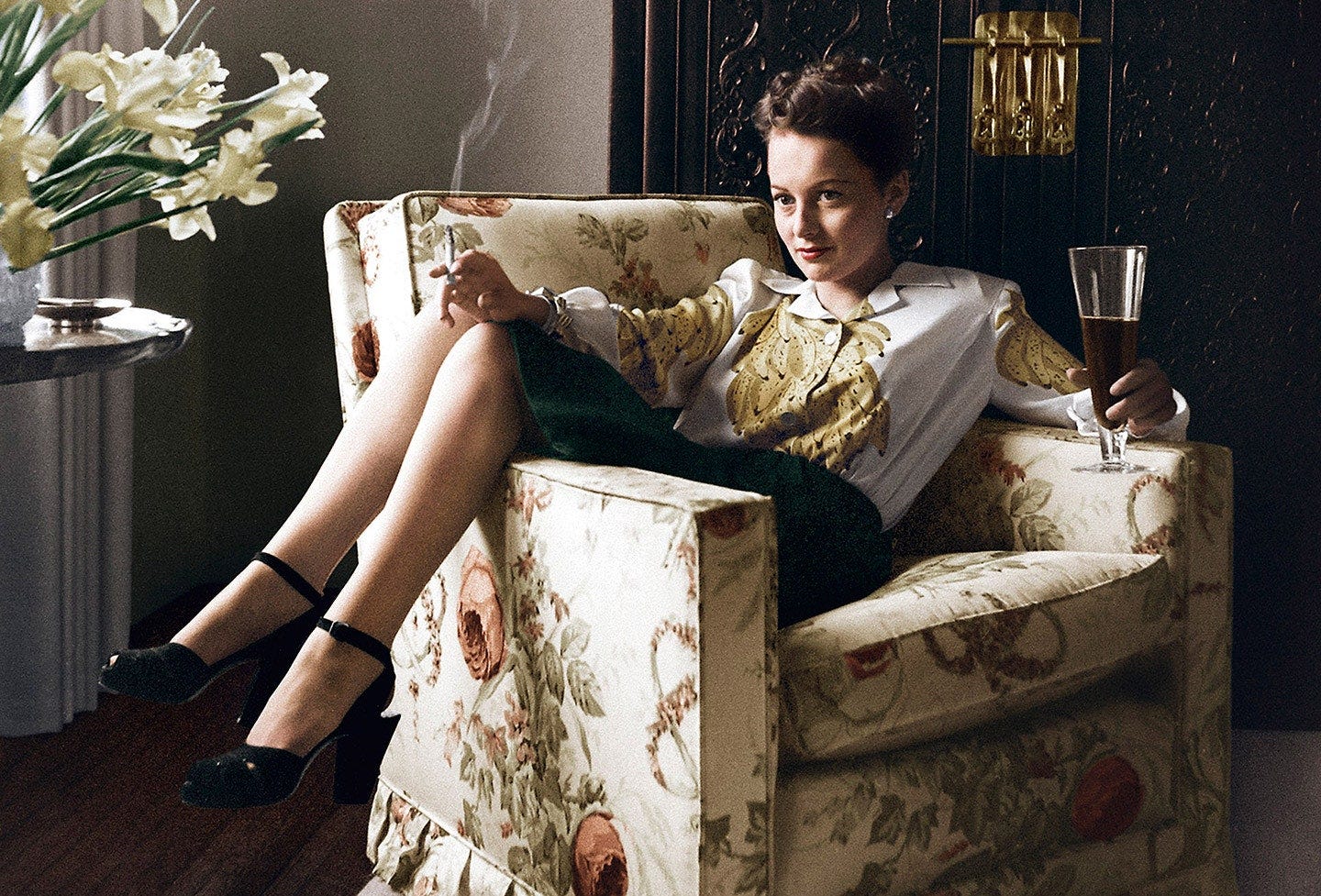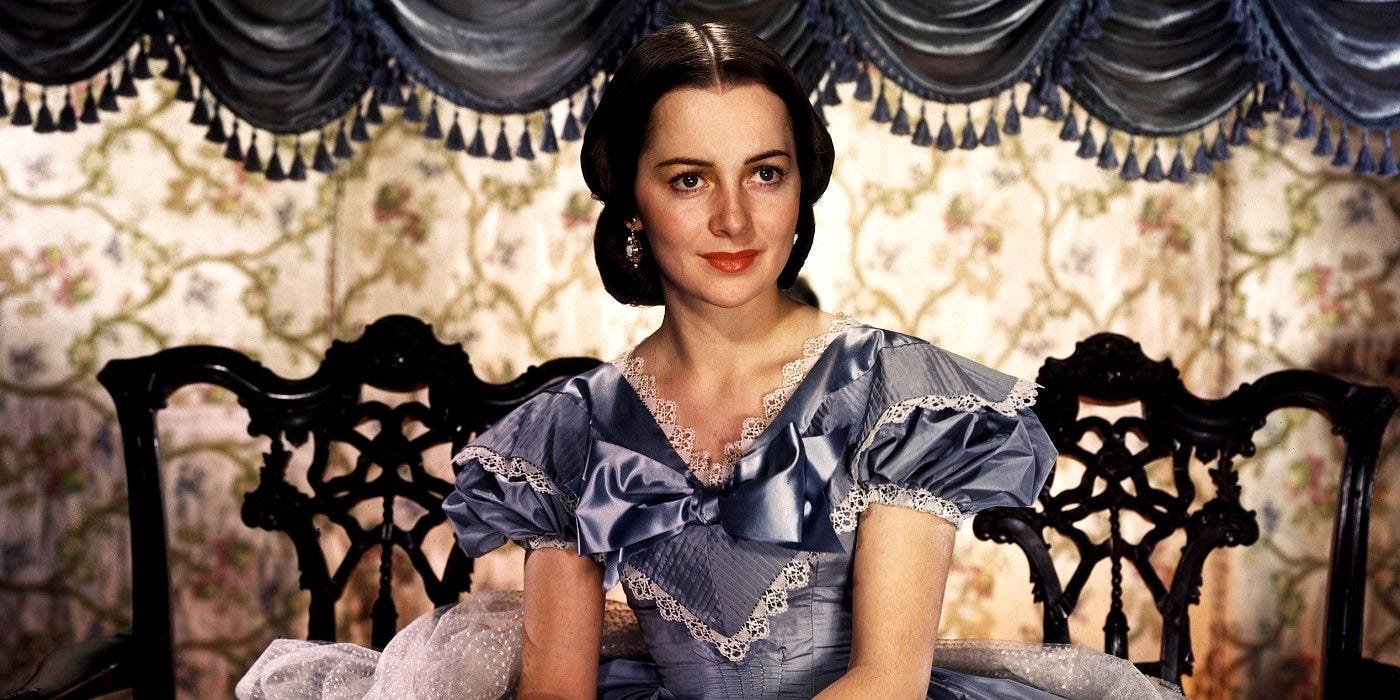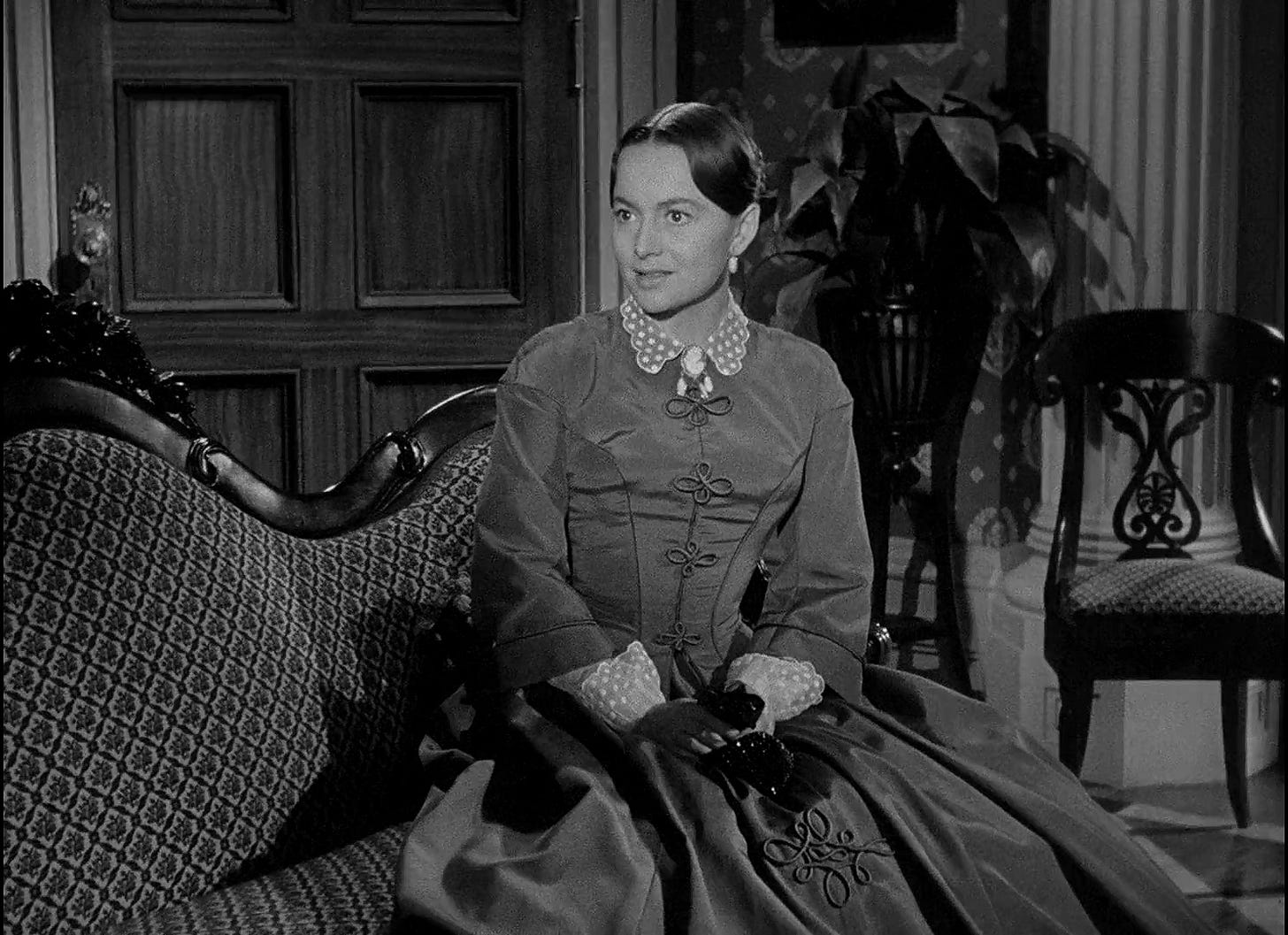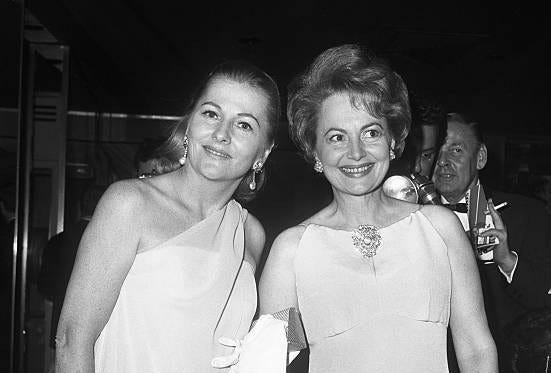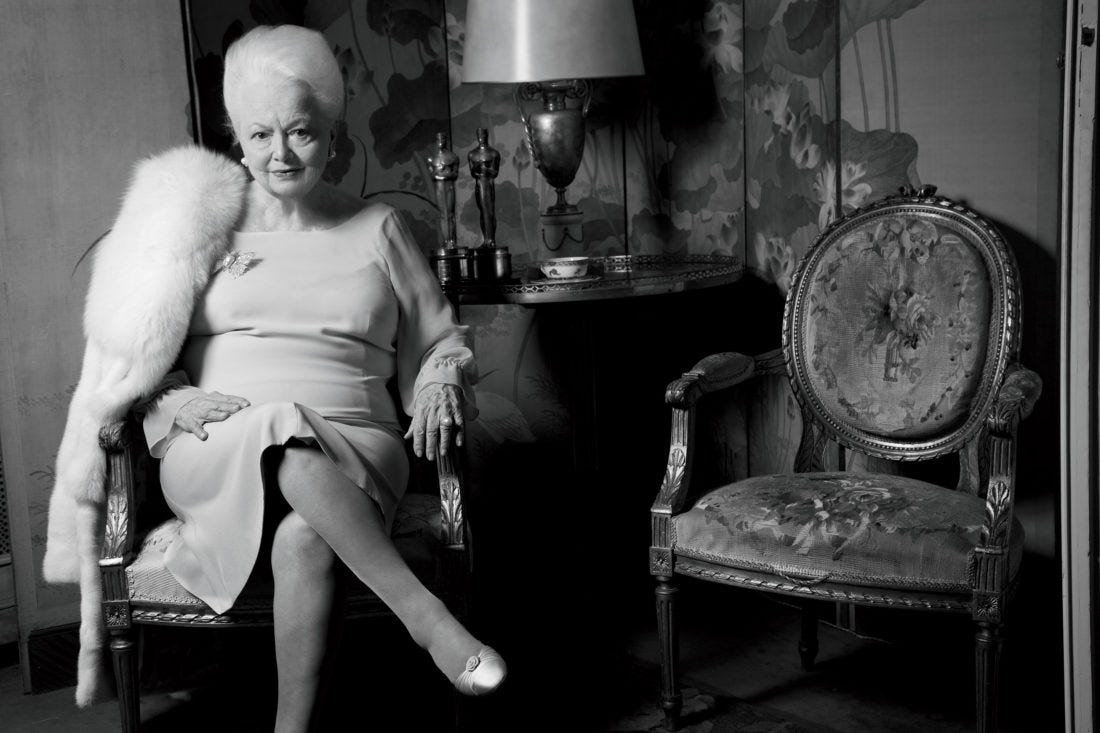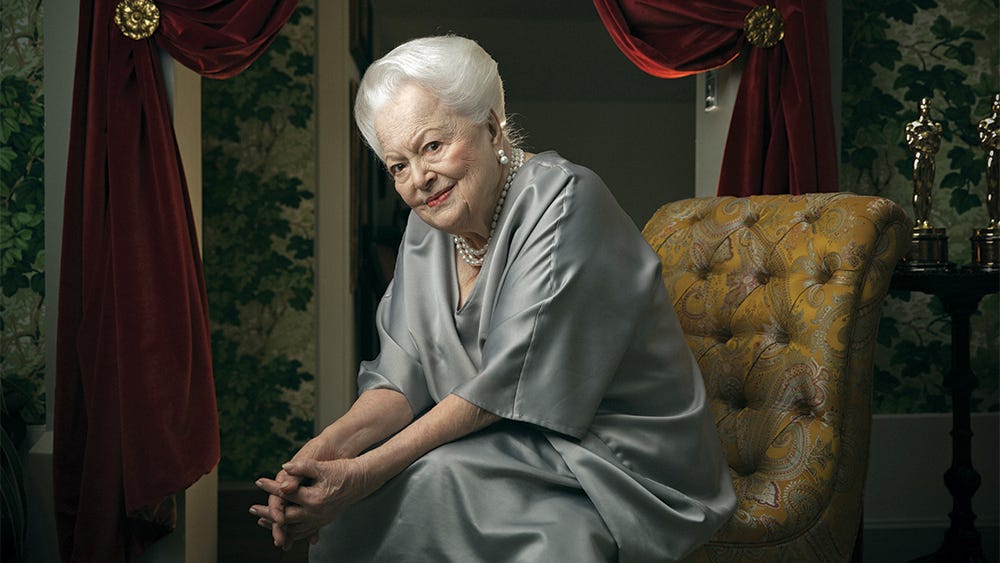If there’s one thing Hollywood loves, it’s a star with drama to spare. But Olivia de Havilland, the icon who mastered the long game, proved that you didn’t need to be loud to change the course of history. Her life was less a Hollywood biopic and more an epic novel—a sprawling tale of quiet rebellion, unyielding principles, and an iron will hidden beneath her signature ethereal grace. She lived through the rise of talkies, the collapse of the studio system, and a rivalry that could have powered several seasons of a Netflix drama.
She wasn’t just the last great actress of Hollywood’s Golden Age; she was its final sovereign, its exiled monarch who lived long enough to see every palace crumble, every courtier fade, and yet never let her crown slip. While contemporaries chased trends or wilted under the glare of modernity, Olivia did something few stars dared—she endured. She didn't just survive the studio system, she beat it. She didn’t just age gracefully; she aged like someone who never owed her beauty to youth in the first place.
Olivia Mary de Havilland was born on July 1, 1916, in Tokyo—a beginning exotic enough to feel fictional. Her father was a British professor and patent attorney; her mother a former stage actress with a talent for Shakespeare and an ambition that seeped into the bloodstream of both her daughters. The marriage didn’t last. Divorce followed, and Olivia, along with her younger sister Joan, was whisked off to sunny California, where they learned English manners under Californian light. The sisters shared more than a bloodline—they shared an early immersion in performance and an equally early undercurrent of rivalry that would one day rupture into legend. As girls, they were competitive. As women, they were nuclear.
California in the 1920s and '30s was fertile ground for ambitious dreamers, and Olivia was as luminous as any casting director could hope for: poised, articulate, and breathtakingly photogenic. Her early stage work in A Midsummer Night’s Dream led to a contract with Warner Bros., and it didn’t take long before she became the ideal romantic lead in a string of Technicolor epics. Paired repeatedly with the dashing Errol Flynn, she lent elegance and emotional shading to films like Captain Blood (1935), The Charge of the Light Brigade (1936), and The Adventures of Robin Hood (1938). They were Hollywood’s golden pair—she, the lady of impossible beauty and poise; he, the devil-may-care heartthrob with just enough danger to make you swoon. But Olivia wasn’t swooning. She was watching, learning, and chafing.
Because for all the glamour, Olivia de Havilland was not content to play the ornament. Beneath the perfectly coiffed hair and modulated tones, she seethed. She read the scripts—truly read them—and recognised the hollowness of her roles. Hollywood wanted her to be decorative. Olivia wanted to be dangerous.
Then came 1939.
For any other actress, Gone with the Wind would have been the summit. Olivia made it her own quiet revolution. As Melanie Hamilton, she played the kind of role actresses dreaded: the “good” woman beside the fiery Scarlett O’Hara. But Olivia made goodness luminous, not passive. She infused Melanie with quiet complexity, with a quiet strength that refused to collapse into blandness. While Vivien Leigh devoured the screen in technicolour turmoil, Olivia held the moral centre—calm, grounded, and utterly unforgettable. The Academy noticed. She was nominated for Best Supporting Actress, but lost to Hattie McDaniel, in a historic win that Olivia publicly celebrated. (Joan, it’s worth noting, would not have.)
But even Gone with the Wind couldn’t insulate her from Warner Bros.’ grip. They continued to assign her to roles she deemed beneath her. If she refused, they punished her by adding time to her contract. It was a gilded cage—and Olivia, unlike so many of her contemporaries, chose to pick the lock.
By the early 1940s, Olivia de Havilland had reached a breaking point. The studio system—Hollywood’s industrial heart—had turned actors into cogs in a relentless machine. Warner Bros., her employer and gaoler, operated like a factory overseen by a foreman with an iron fist. Contracts were less about artistic collaboration and more about ownership; actors were leased commodities bound to the whims of studio executives. If an actor dared to refuse a role, the punishment was swift and cruel: suspension without pay, and an extension of their contract’s duration to compensate for lost time. This practice, known as “the stretch-out,” was little more than indentured servitude disguised in the gloss of showbiz glamour. And Olivia, who had spent years chafing under this yoke, was done playing by their rules.
In 1943, she did what no one expected—she sued Warner Bros. The lawsuit was a David versus Goliath battle, a quiet but ferocious revolt against an entrenched power structure that had ruled Hollywood with near-absolute control. The case, De Havilland v. Warner Bros., became a defining moment in entertainment history. No actress had ever dared take on the studios so directly—and no actress had ever won. The California courts delivered a landmark ruling: personal service contracts could not be extended beyond seven calendar years, regardless of suspensions. This “De Havilland Decision” didn’t merely free Olivia from her oppressive contract; it cracked open the very foundations of the studio system. It was a seismic shift that rippled through Hollywood, loosening the studios’ iron grip and granting actors a new measure of autonomy. Every performer today—from marquee names commanding huge salaries to indie actors fighting for their roles—owes a silent debt to Olivia’s courage. She didn’t raise her voice in a public frenzy. She raised the stakes quietly, but irrevocably.
Her legal victory ushered in a creative renaissance. No longer tethered to the scraps tossed her way by Warner Bros., Olivia sought roles that demanded depth, nuance, and emotional excavation. To Each His Own (1946) was a revelation—a portrait of a mother forced to abandon her child, layered with heartbreak, dignity, and resilience. Her performance earned her the Academy Award for Best Actress, a recognition that felt both overdue and richly deserved. But Olivia didn’t stop there. With The Snake Pit (1948), she ventured into uncharted territory, portraying a woman trapped in the bleak, harrowing world of a mental institution. The film’s frank depiction of mental illness was groundbreaking and uncomfortable, and Olivia’s unflinching portrayal shattered taboos, proving her fearless commitment to challenging material.
Then came The Heiress (1949), a masterpiece that would become her signature. As Catherine Sloper, the painfully shy, emotionally starved heiress, Olivia delivered a performance of almost supernatural subtlety. The transformation from timid girl to cold, calculating woman scorned was so seamless it felt less like acting and more like alchemy. The film’s climax—her silent, steely refusal to reopen the door to her deceitful suitor—stands as one of cinema’s most haunting expressions of quiet vengeance. No tears, no screams—just the cold, resolute power of a woman who has learned to protect herself, at any cost.
As her contemporaries aged out or faded away, Olivia remained a force to be reckoned with. In 1964, she took on a role that seemed almost scripted by fate itself. Stepping in for Joan Crawford at the last minute in Hush… Hush, Sweet Charlotte, she reunited with Bette Davis in a Southern Gothic tale dripping with menace and melodrama. The casting twist felt like a symbolic passing of the torch, or perhaps a final act in an ongoing saga of Hollywood’s grand dames. Olivia’s portrayal of the elegant, cunning cousin—venom behind the lace—proved that she could still wield ambiguity and power with unnerving ease. It wasn’t a desperate comeback; it was a victory lap, a graceful assertion that the queen was still very much on her throne.
Off-screen, Olivia de Havilland lived with the same elegance and sense of self-direction that defined her career—but her personal life was far from a costume drama in soft focus. She married twice: first to novelist Marcus Goodrich in 1946, a union that yielded her son Benjamin and ended in divorce seven years later. Then to French journalist Pierre Galante in 1955, with whom she had a daughter, Gisèle. Though they divorced in 1979, theirs remained a warm and civil friendship—Galante even moved into Olivia’s guest room when he was dying of cancer, and she cared for him until the end. For someone who had been mistaken so often for her delicate on-screen roles, there was nothing fragile about her loyalty. She loved deeply, but privately. Her life was not tabloid material; it was curated, cultivated, and kept at a distance from Hollywood’s gluttonous gaze.
But the most famous, or infamous, relationship in Olivia’s life wasn’t romantic—it was sororal. The feud between Olivia and Joan Fontaine wasn’t just sibling rivalry; it was Greek tragedy in satin gloves. Born just fifteen months apart, the sisters were raised under the same roof but in entirely different emotional climates. Their mother, fiercely ambitious, reportedly favoured Olivia, while Joan—ever the contrarian—became an actress partly out of spite, even adopting a stage name to escape her sister’s shadow. Hollywood, always eager to stir the pot, delighted in fanning the flames. Journalists chronicled their icy red-carpet standoffs and pitted their performances against one another like gladiators in chiffon.
The climax came at the 1942 Oscars, when both were nominated for Best Actress. Joan won, and when Olivia approached to congratulate her, Joan—according to legend and Olivia—recoiled. Two years later, Olivia took home the Oscar herself, and in her speech, made no mention of her sister. It was not a quarrel—it was a cold war. Over the decades, they maintained their estrangement with imperial discipline, missing each other’s weddings, children, and funerals. When Joan died in 2013, Olivia issued a terse public statement—“shocked and saddened”—but didn’t attend the memorial. For all the roles they played in fiction, this unresolved sibling drama may have been their most enduring and unscripted performance.
While many of her contemporaries sank into the fog of nostalgia or simply faded into obscurity, Olivia de Havilland charted a course less travelled—a graceful exile to Paris, the city of light, love, and timeless elegance. After her first marriage to the American novelist Marcus Goodrich ended in divorce, Olivia found new beginnings across the Atlantic. She married Pierre Galante, a respected French journalist and editor, who became both her partner and lifelong friend. Settling into the rhythm of French life, Olivia transformed herself from Hollywood’s golden girl into a cosmopolitan doyenne, embodying a rarefied blend of Old World charm and modern independence. Paris was more than a backdrop—it was her sanctuary, a place where she could cultivate a life of elegant detachment from the relentless machinery of the American film industry that had once both made and nearly broken her.
Though she retreated from the spotlight’s harsh glare, Olivia never abandoned the craft she loved. She appeared intermittently in European films and television, choosing roles that complemented her maturity and unmistakable poise. Rather than chasing stardom, she embraced the artistry of aging with dignity—proving that actresses could evolve beyond ingénue roles without losing their allure or relevance. Her 1962 memoir, Every Frenchman Has One, revealed a witty and self-aware observer of French culture, revealing the private woman beneath the public icon. She moved effortlessly among Parisian high society, attending soirées and salons, her presence commanding respect rather than craving attention. By the time she reached her later decades, she had become a cinematic dowager empress—regal, discerning, and unyielding. But make no mistake: behind the soft silk and delicate pearls was a woman who had never been a pushover.
When FX’s Feud: Bette and Joan aired in 2017, the series painted Olivia as a mere gossip, a sidelined shadow in the legendary rivalry between Joan Crawford and Bette Davis. At the remarkable age of 101, Olivia did what she had done decades earlier—she took a stand. She sued the producers for defamation, demanding respect for her legacy. The court ultimately ruled in favor of artistic license, but Olivia’s lawsuit was quintessentially her: precise, principled, and unbowed. This was not vanity or bitterness; it was a guardian’s defence of truth. Her life had been carved with integrity, and she would not allow her story to be twisted or trivialized by those who sought to sensationalize it.
And so, Olivia de Havilland lived—through wars that reshaped the world, economic upheavals, social revolutions, and the dizzying tides of modern history. She bore witness to McCarthyism’s shadow, the civil rights movement’s righteous roar, the turmoil of Vietnam, the seismic shock of 9/11, the political tremors of Brexit, the upheaval of Trump’s America, and the surge of the #MeToo movement—each era layering new complexities onto her already rich tapestry. When she finally passed away in 2020, at the age of 104, she had outlived nearly everyone who had once shared her stage and screen—and certainly outlasted those who had ever underestimated her tenacity. Outside, the world grappled with a global pandemic; inside her Parisian home, Olivia slipped away with the same quiet grace that had defined her entire existence—no grand finale, no desperate spectacle. Just a sovereign departure, fitting for a woman who played the long game—and won.
But her legacy is not just longevity. It is lucidity. Olivia de Havilland was a woman who knew exactly what she was doing—from the roles she accepted to the battles she chose to fight. She embodied dignity without sanctimony, rebellion without tantrum. She fought for actors’ rights, artistic autonomy, and the right to age on her own terms. She did not need to be a martyr or a mess to be legendary. She was neither Norma Desmond nor Marilyn Monroe. She was something rarer: a woman who grew up in front of the camera and refused to be consumed by it.
In a culture that often confuses fame with meaning, Olivia gave us something else entirely: endurance with purpose. Even her silences felt deliberate. Even her exits had timing.
She didn’t just play characters on screen; she embodied the arc of Hollywood itself—its glamour, its grit, and its capacity for reinvention. She was the industry’s conscience in chiffon, its whistleblower in pearls. If Greta Garbo vanished and Bette Davis exploded, Olivia de Havilland endured.
And when the lights dimmed, and the soundstages emptied, she was still there—like a statue the world forgot to tear down.
Not loud, just lasting. Not showy, just sovereign.
Here’s to Olivia de Havilland; the woman who played the long game—and won.




